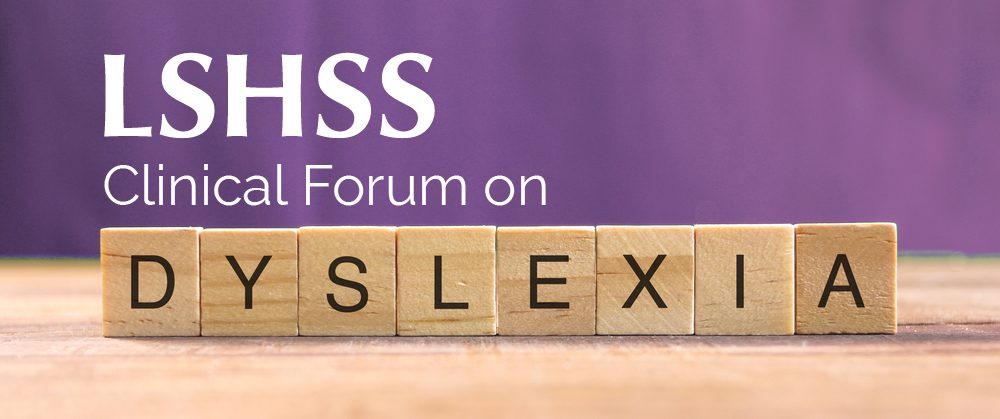Have you heard of dyslexia? Chances are you probably have. Dyslexia is a widely known condition but unfortunately it is also widely misunderstood.
Wait, I’m an SLP…is it in my scope of practice to work with children who have dyslexia? Yes, it is within our scope of practice (American Speech-Language-Hearing Association, 2001, 2016). Even so, the majority of school-based SLPs report that their educational and clinical training was sparse on the evaluation and treatment of children with written language disorders, such as dyslexia. Those who say they feel comfortable in their ability to assess, treat and consult on comprehension of written text report less confidence when assessing, treating, or consulting on word reading and dyslexia.
My first exposure to dyslexia was in my clinical fellowship year when I was asked to create a pre-literacy intervention group for preschool children on my hospital’s waiting list. Like many SLPs, I had no formal training in literacy or dyslexia, which made me uncertain about my ability to create and lead a pre-literacy group. Thankfully, this early clinical assignment led me to learn more. Now, after almost two decades of conducting studies on the language basis of reading it is my honor to lead a forum to provide a broad survey of up-to-date, evidence-based information about dyslexia that I believe can be readily applied to SLP clinical practice.
Though there have been numerous papers written on the topic of dyslexia, this clinical forum is unique in that it is the only combination of papers to focus on dyslexia with the speech-language pathologist in mind.
In this clinical forum, eleven papers (plus a prologue and an epilogue) overview a range of topics to provide the state-of-the-science on dyslexia, including (a) theoretic and clinical frameworks for understanding dyslexia in relation to other language-based communication disorders, (b) the neuro-biological basis of dyslexia, (c) the current state of dyslexia legislation and using the label ‘dyslexia’ in schools, (d) issues around identification of dyslexia, (e) and evidence-based reviews of instruction for reading and writing.
In the final paper I present 5 ways in which I believe speech-language pathologists can make a positive impact on children with dyslexia.
After reading these papers it is my hope that you will feel more confident in your knowledge of dyslexia. How you use that knowledge to improve the lives of these children is up to you. Whether it be through assessment, treatment, policy change, parent and teacher training, or advocacy, SLPs are in a unique position to make a positive impact in the lives of those with dyslexia.
Explore the Clinical Forum
Hogan, T. P. (2018). What speech-language pathologists need to know about dyslexia. Language, Speech, and Hearing Services in Schools, 49(4), 759–761. https://doi.org/10.1044/2018_LSHSS-DYSLC-18-0098
Adlof, S. M., & Hogan, T. P. (2018). Understanding dyslexia in the context of developmental language disorders. Language, Speech, and Hearing Services in Schools, 49(4), 762–773. https://doi.org/10.1044/2018_LSHSS-DYSLC-18-0049
Cabbage, K. L., Farquharson, K., Iuzzini-Seigel, J., Zuk, J., & Hogan, T. P. (2018). Exploring the overlap between dyslexia and speech sound production deficits. Language, Speech, and Hearing Services in Schools, 49(4), 774–786. https://doi.org/10.1044/2018_LSHSS-DYSLC-18-0008
Saletta, M. (2018). Reading disabilities in adolescents and adults. Language, Speech, and Hearing Services in Schools, 49(4), 787–797. https://doi.org/10.1044/2018_LSHSS-DYSLC-18-0005
D’Mello, A. M., & Gabrieli, J. D. E. (2018). Cognitive neuroscience of dyslexia. Language, Speech, and Hearing Services in Schools, 49(4), 798–809. https://doi.org/10.1044/2018_LSHSS-DYSLC-18-0020
Ward-Lonergan, J. M., & Duthie, J. K. (2018). The state of dyslexia: Recent legislation and guidelines for serving school-age children and adolescents with dyslexia. Language, Speech, and Hearing Services in Schools, 49(4), 810–816. https://doi.org/10.1044/2018_LSHSS-DYSLC-18-0002
Colenbrander, D., Ricketts, J., & Breadmore, H. L. (2018). Early identification of dyslexia: Understanding the issues. Language, Speech, and Hearing Services in Schools, 49(4), 817–828. https://doi.org/10.1044/2018_LSHSS-DYSLC-18-0007
Al Otaiba, S., Rouse, A. G., & Baker, K. (2018). Elementary grade intervention approaches to treat specific learning disabilities, including dyslexia. Language, Speech, and Hearing Services in Schools, 49(4), 829–842. https://doi.org/10.1044/2018_LSHSS-DYSLC-18-0022
Hebert, M., Kearns, D. M., Hayes, J. B., Bazis, P., & Cooper, S. (2018). Why children with dyslexia struggle with writing and how to help them. Language, Speech, and Hearing Services in Schools, 49(4), 843–863. https://doi.org/10.1044/2018_LSHSS-DYSLC-18-0024
Rappolt-Schlichtmann, G., Boucher, A. R., & Evan, M. (2018). From deficit remediation to capacity building: Learning to enable rather than disable students with dyslexia. Language, Speech, and Hearing Services in Schools, 49(4), 864–874. https://doi.org/10.1044/2018_LSHSS-DYSLC-18-0031
Petersen, D. B., Gragg, S. L., & Spencer, T. D. (2018). Predicting reading problems 6 years into the future: Dynamic assessment reduces bias and increases classification accuracy. Language, Speech, and Hearing Services in Schools, 49(4), 875–888. https://doi.org/10.1044/2018_LSHSS-DYSLC-18-0021
Yamasaki, B. L., & Luk, G. (2018). Eligibility for special education in elementary school: The role of diverse language experiences. Language, Speech, and Hearing Services in Schools, 49(4), 889–901. https://doi.org/10.1044/2018_LSHSS-DYSLC-18-0006
Hogan, T. P. (2018). Five ways speech-language pathologists can positively impact children with dyslexia. Language, Speech, and Hearing Services in Schools, 49(4), 902–905. https://doi.org/10.1044/2018_LSHSS-DYSLC-18-0102







